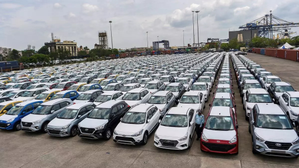India’s auto sector not likely to face major impact due to US tariff hike

New Delhi, Feb 14 (IANS) Indian automotive manufacturers are not likely to face any major impact due to US President Donald Trump’s reciprocal tariffs as these companies sell their products largely in the fast-growing domestic market, according to analysts.
“OEMs (original equipment manufacturers) are largely insulated due to heavy localisation and sales, and minimal US exports,” said Puneet Gupta, a director at S&P Global Mobility – India and Asean.
“India is also a preferred partner of the US, and the only alternative to China for American automakers to source auto components,” he added.
Royal Enfield, may be an exception as the bike-making arm of Eicher Motors Ltd., as the US is a major export market for its 650 CC motorcycles. Some auto component makers may be also be affected due to higher tariffs.
On Thursday, Trump ordered his administration to consider imposing reciprocal tariffs on numerous trading partners, raising the prospect of a wider campaign against a global system he says is tilted against the US. “I’ve decided, for purposes of fairness, that I will charge a reciprocal tariff, meaning whatever countries charge the United States of America,” Trump said in the Oval Office.
He also mentioned India for its high tariff barriers.
According to a Morgan Stanley report, the direct impact of reciprocal tariff hikes by the US will likely be manageable but, the indirect impact through uncertainty weighing on business confidence is more worrisome. However, domestic policy will likely remain supportive of growth and incrementally more measures will be taken if downside risks emerge.
Prime Minister Narendra Modi and President Trump have, in their joint statement, resolved to expand trade and investment to make their citizens more prosperous, nations stronger, economies more innovative and supply chains more resilient. They resolved to deepen the U.S.-India trade relationship to promote growth that ensures fairness, national security and job creation. To this end, the leaders set a bold new goal for bilateral trade – “Mission 500” – aiming to more than double total bilateral trade to $500 billion by 2030.
Recognising that this level of ambition would require new, fair-trade terms, the leaders announced plans to negotiate the first tranche of a mutually beneficial, multi-sector Bilateral Trade Agreement (BTA) by fall of 2025. The leaders committed to designate senior representatives to advance these negotiations and to ensure that the trade relationship fully reflects the aspirations of the COMPACT. To advance this innovative, wide-ranging BTA, the U.S. and India will take an integrated approach to strengthen and deepen bilateral trade across the goods and services sector, and will work towards increasing market access, reducing tariff and non-tariff barriers, and deepening supply chain integration.
Both sides also pledged to collaborate to enhance bilateral trade by increasing U.S. exports of industrial goods to India and Indian exports of labor-intensive manufactured products to the United States. The two sides will also work together to increase trade in agricultural goods.
Finally, the leaders committed to drive opportunities for U.S. and Indian companies to make greenfield investments in high-value industries in each other’s countries. In this regard, the leaders welcomed ongoing investments by Indian companies worth approximately $7.35 billion, such as those by Hindalco’s Novelis in finished aluminum goods at their state-of-the art facilities in Alabama and Kentucky; JSW in steel manufacturing operations at Texas and Ohio; Epsilon Advanced Materials in the manufacture of critical battery materials in North Carolina; and Jubilant Pharma in the manufacture of injectables in Washington. These investments support over 3,000 high-quality jobs for local families.
–IANS
sps/na




